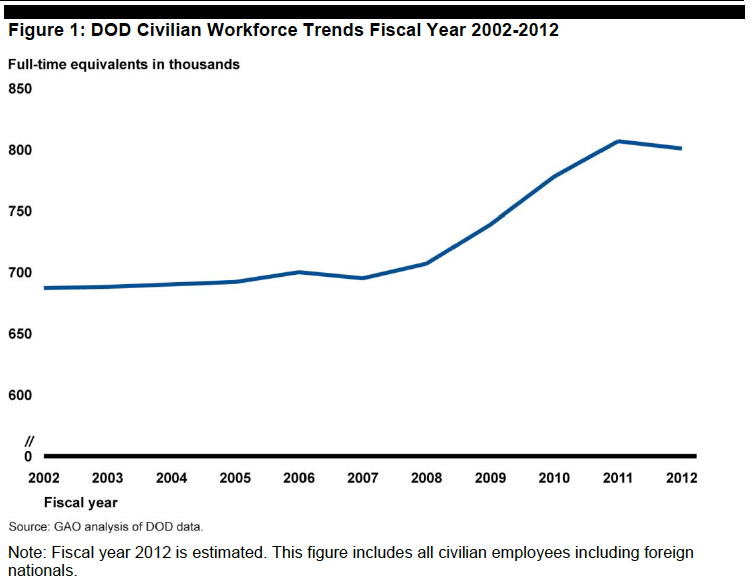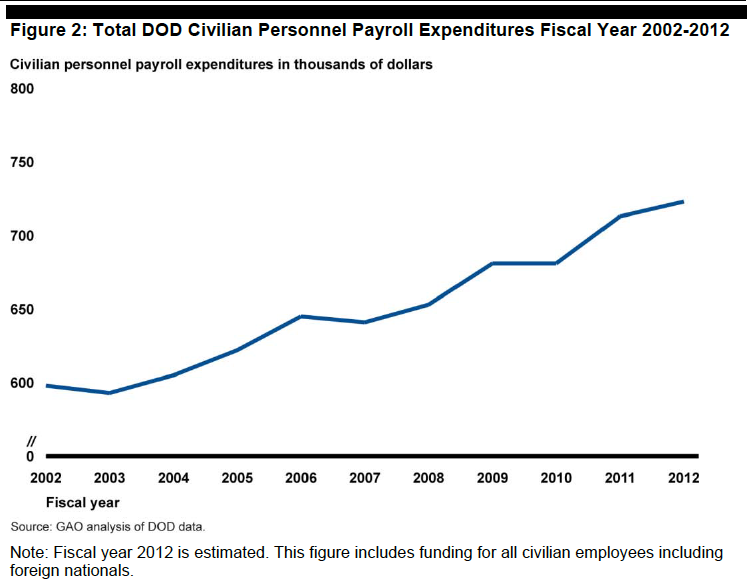The Pentagon, headquarters of the Department of Defense since 1943.
So there was conservative columnist George Will’s list of questions for defense-secretary nominee Chuck Hagel in the lead slot on the op-ed page of Thursday morning’s Washington Post:
Do you agree with Defense Secretary Leon Panetta’s judgment that cuts under sequestration would “hollow out the force”? Can you give examples of procurements or deployments that justify your description of the Defense Department as “bloated”?
Like clockwork, on Thursday afternoon the Government Accountability Office issued a report detailing Pentagon personnel bloat. (No, Will’s column didn’t trigger the report: the release of a GAO report has nearly as much lead time as a manned rocket launch [youngsters: ask your parents])
In a study with the eye-glazing title Human Capital: Critical Skills and Competency Assessments Should Help Guide DOD Civilian Workforce Decisions was this chart, which shows the number of civilian personnel working for the Pentagon rising steadily over most of the past decade.
“DOD’s total civilian has reached approximately 800,000 FTEs [full-time equivalents, in which part-time workers are lumped together to generate FTEs], which constitutes approximately 17 percent growth since 2002, most of which has occurred since 2008,” the GAO says. “In fiscal year 2012 alone, DOD budgeted approximately $72 billion for its civilian personnel, an increase of approximately $12.6 billion, or 21 percent, since fiscal year 2002.”
Here’s how much these folks are costing us (although the key saying it’s in “thousands of dollars” can’t be right; elsewhere in the report it says the 2012 total is $72 billion, so the GAO appears to be off here…just a tad. A big tad.). Nonetheless, the incline is what’s important.
Anyway, there’s nothing new here. Nearly a quarter-century ago, Battleland looked into what it called “a bloated military” following then-Defense Secretary Frank Carlucci’s 1987 order to cut 3,000 military officers from headquarters staffs.
Two years later, in 1989, a Pentagon investigation showed:
…the military services eliminated 2,970 slots, but 2,244 people who held those positions were transferred to other jobs. The Army cut 1,120 positions, while adding 1,123 through transfers, for a net gain of three. The Navy dropped 650 jobs and shifted 654, for a gain of four. The Marines removed 39, while picking up 41 new posts, gaining two. Only the Air Force recorded a net job loss. It slashed 1,161 positions and transferred 426, for a net loss of 735.
The Pentagon inspector general also had recommended that 51 slots held by admirals and generals be eliminated. After two years, 51 remained filled.
But none dare call it bloat.




